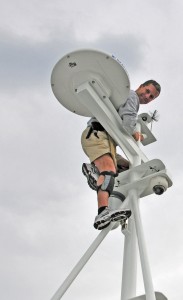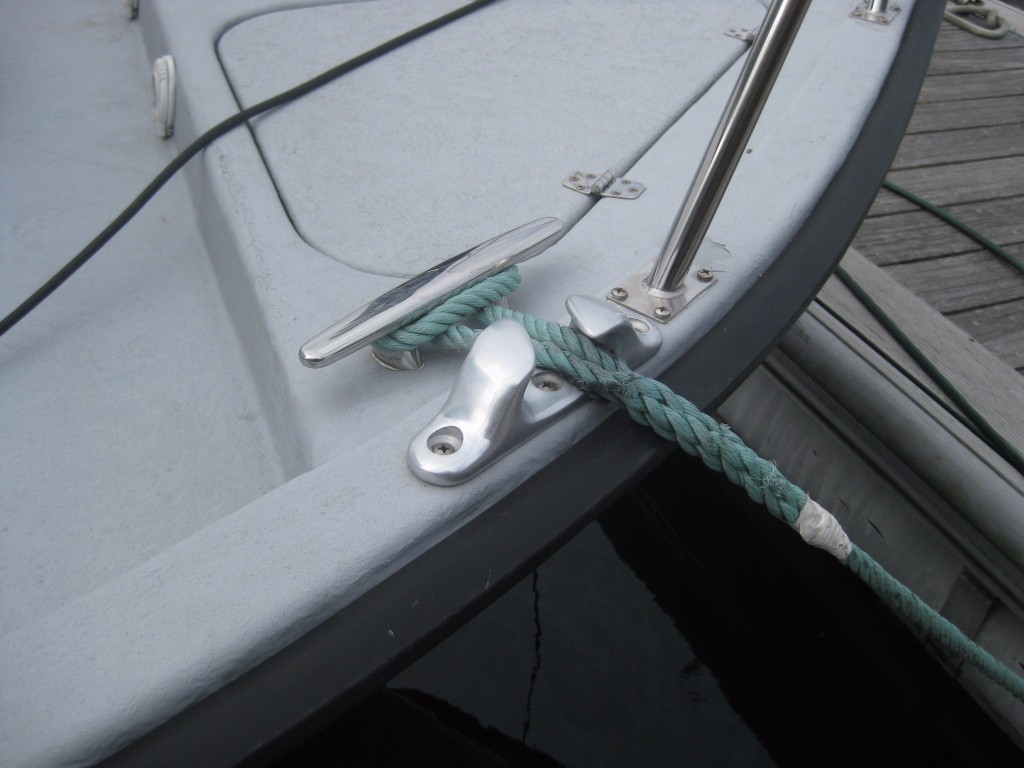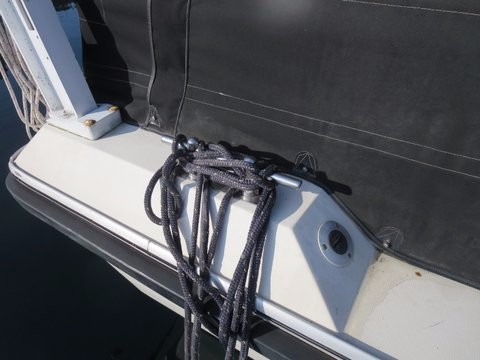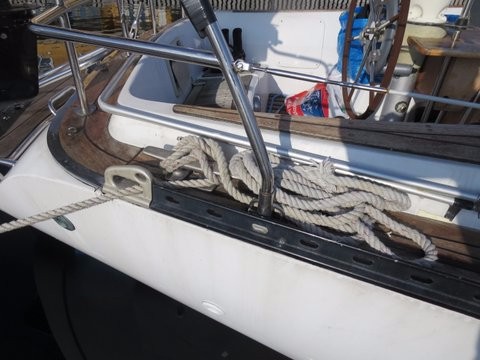From the Editor

Among other things, I had an opportunity to delve into Australia’s very well-developed boat building trades and standards program. Unlike the United States, where few regulations govern how recreational vessels are built (ABYC Standards, which I cite routinely, are purely voluntary) the Australians have codified, in their own states’ law, the electrical standards that all boats sold in Australia must meet, AS/NZS3004.2 ‘Boat Installations’, and commonly referred to as the “Wiring Rules”. This standard references and draws on, among others, our own ABYC Standard, and there are many similarities, however, in some ways the Australian Standard is more rigorous. For example, every receptacle aboard must be of the GFCI type, rather than just those in the head, galley, machinery spaces and on deck, and every receptacle and electric motor must include an adjacent isolation switch. Furthermore, those working on marine electrical system must be certified and licensed. As a result, generally, electrical systems aboard vessels sold and used in Australia tend to be safer and more reliable than those in the US, (in the case of vessels that do not meet ABYC electrical standards, and aren’t required to do so, and where marine electricians need not be certified), and I suspect it also adds to the cost, although it’s hard to say how much. A better designed, competently installed electrical system is not only safer, it’s more reliable and therefore less expensive to own.
Is it a system worthy of emulation, would it make sense to require boats sold in the US to meet ABYC electrical standards, and for electricians to be certified? That’s a subject that’s been debated, albeit not seriously, within the US marine industry for some time. The number of boats, boat owners, builders and yards in the US far exceeds that of Australia, and so many believe the question really is, if such small countries (Australia and New Zealand), with comparatively small marine industries, have adopted this protocol, why haven’t we done so as well? Doing so would mean the introduction of US federal legislation into the recreational boat building, and repair worlds, something many in the industry dread. However, unless the US marine industry, including builders, yards and independent contractors, embrace the existing voluntary ABYC standard, it’s unlikely we’ll ever reach the level of safety, reliability and proficiency found in Australia and New Zealand, again without ABYC compliance (my point being, and by comparison, I believe a vessel that complies with the Australian/NZ electrical standard is safer and more reliable, on the whole, than a US vessel that fails to comply with ABYC electrical standards). Perhaps readers have an opinion, would you be willing to pay more for a boat, or repairs, if you could be assured the vessel’s electrical system met a higher standard?
This month’s Ezine feature, on the subject of cleats and the proper use thereof, is written by experienced cruiser and regular contributor Dick Stevenson. I hope you find it both interesting and useful.
Text and photos by Dick Stevenson
Copyright 2015 SDMC, Inc.

A proper cleat hitch, note the last bend, the two lines are parallel. It’s easy and safe to surge a few inches or release. This is how cleats were designed to be used.
Those of us who mess around in boats have the joy of using certain items to which the shore based world just never get introduced. There are pieces of gear that are so perfectly evolved over time, so brilliant in their use, so simple and versatile, and so ubiquitous, that we ourselves barely think of them or know they are there. Cleats are one such piece of gear. The inventor is surely lost in the mists of time, but every manufacturer has “perfected” a version; you can see the various permutations on any stroll through a marina. But they all work alike.
This article is not only an homage to this little heralded piece of boat gear, but includes suggestions on the proper (and by proper, I mean safest, easiest and most seamanlike) way to use them. It includes a challenge to the habits of many boaters which might be disconcerting at first, but may be very much appreciated when our everyday weather gets ugly and we need to access our cleats’ every attribute.

The proverbial Gordian knot…while it’s doing the job it is sloppy and would be difficult to release quickly.
For the moment, let’s just think about the amazing feats a cleat can accomplish. It can belay (secure) a line that will hold in a hurricane. The belay is quick and easy to execute safely, and, more importantly, quick and easy to cast off. Even better, one can surge (bleed off and loosen) the line safely and with perfect control. Just sit with this a moment: a perfectly secure belay which is easy and safe to surge a few inches or to cast off completely. And, you can safely do so even when the line is under great tension. That is an impressive achievement. Caveats are few: common sense dictates that line size must be appropriate to cleat size; lines must be a reasonable length, strong, and with no knots or splices; and some of the modern slippery lines benefit from an extra figure of eight loop prior to the half hitch.

Spliced loops have a place aboard but not on the dock side cleat unless you are willing to abandon or cut the line.
However, nowadays it is hard to buy a designated dock line without a spliced loop, which undermines most of those attributes of a cleat that make it versatile. So many just use the loop and rarely think about it. Skippers I have talked to say that it is convenient to just drop the loop over the cleat either on the deck or the dock, and that instructions to guests are easy, which are valid comments. However, though a spliced loop may seem to be an innocuous aid to securing the boat, its use holds serious dangers to person and boat if the weather turns boisterous. And even at the most benign of times, there are real functional drawbacks.

A common usage, not so secure if the line becomes stiff and the boat bounces around.
Attaching and/or releasing a spliced eye from a cleat is too often attempted when the vessel is moving and/or the line is too short for easy use. When pressure is about to be taken up on the line, often unexpectedly, pushing a loop under and around a cleat, prying the loop off, or pulling the loop to get it over the horn entails getting your hands and fingers in the middle of the action area, leading to injuries. On the other hand, belaying a dock line onto a cleat (vs dead-ending as a loop does) is always safe as fingers need never get between line and cleat, and control is gradually increased with each added turn of the line. As well, when you aren’t worrying about lines, you can focus on keeping yourself and the boat safe.

Imagine where your fingers and hands would need to be if you needed to release this under tension, or if the vessel is heaving.
Just give the following scenario a moment of your imagination.
Scene one: The wind is up and there is some chop, and boat safety dictates you leave the dock. Your crew is attempting to pry a spliced loop from a cleat. The vessel is jumping about and the line is on again /off again, slack and then loaded. It is tempting, maybe necessary, to release in a way that leads fingers and/or hand to being inserted between the line and the cleat, as the attempt is made to pull the loop clear of the cleat. Good timing and strength is often needed and if the boat jumps at the wrong moment, fingers will be mangled as the line mashes the hand into the cleat. Contrast this to releasing the hitch and lifting the line from the cleat allowing line to bleed off, or just undoing the belay with the line smoothly pulling away from the cleat. No strength necessary or impeccable timing needed. Hands and fingers need never be between the rope and the cleat, and thus are safe throughout the manoeuvre. A similar possibility of hand damage occurs when trying to secure a boat to a dock with a spliced line.

A common sight, and not a pretty one. This is not only sloppy, it too is difficult to release quickly.

Hitching every turn is not proper cleat etiquette, while secure, it makes a quick release impossible.
Spliced dock lines have drawbacks even in everyday docking activities in quiet weather.
- It is impossible to adjust line length with a spliced loop. It is either completely “on” the cleat or completely “off”. There is no middle ground. A line belayed properly on a cleat is always able to have some surged off if, as should be the habit, leaving some spare to work with. Similarly, if need be, line can be taken in. This can be done safely by “sweating” the line in or with the engine assisting.
- Some like the idea that an eye splice will always achieve the correct line length allowing accurate tie ups at repeat locations. There is, however, an easy alternative: an elegant seamanlike whipping, colored for visibility, and strategically situated to allow the line to be belayed to the cleat repeatedly, at the same length.
- Others might argue that it takes time to tie onto a cleat: done properly, tying onto a cleat should take but a moment.
- Sometimes a loop is necessary or handy, say to go over a post. It is easy to tie an appropriately sized eye with a bowline, or, better yet, a clove hitch or tugboat hitch, both knots that can be adjusted under pressure.
- Some docks have no cleats or posts but are festooned with a myriad of other fasteners. A spliced loop will work with some and be impossible with others. An un-altered dock line has the flexibility to always find a solution.
- Other problems with a spliced eye in a dock line occur when attempting to lead the splice through a fairlead or hawse, where the fatter splice does not run freely or gets jammed. An un-spliced line will run free with much less likelihood of getting caught on something.
- Finally, a spliced loop can make the line more difficult to use for other purposes, where an eye may not be wanted, or the whole length of the line is wished for.

This will likely be able to be released under pressure, but really, why not use a cleat hitch?
Two more scenarios:
Scene two: You awaken to find you must adjust dock line length. The wind is up and you are bouncing about. You have spliced loops around the cleats on your deck so they are dead-ended: un-adjustable. The dock is bouncing, wet & slippery and you are now a few foot leap to the dock which, when you went to bed, you were snugly against. With the line properly belayed on the deck cleat, all involved stay on the boat and letting out more line is easy and safe. Taking in line only entails either sweating the line in or starting the engine and horsing the boat into a better position while the crew, never needing to leave the safety of the boat, takes in slack in the dock line on the cleat as it’s available, again safely and in control.

Acceptable perhaps, but overdone. Neatness counts when making cleat hitches, it prevents binding, and ensures releases can be accomplished quickly and easily.
Scene three: You are being blown off the dock by a fine breeze and itching to get underway. The spliced loop of your dock line is around the cleat on the dock. No amount of pulling allows enough slack to get the dock line free. The engine is on and you believe that you can manoeuvre the boat to allow slack to get the loop free only to realize that the person left holding the loop will neither be able to hold the boat nor make a flying leap, loop in hand, to a rapidly retreating vessel. The skipper starts to contemplate how a knife might solve his or her immediate problem.
A knife, in fact, is the only way to release a spliced line under pressure on a cleat.

A good try, but the half hitch is piled on rather than laid alongside and will jam under load.
In summary, from my perspective as an experienced mariner, the proper use of a cleat is an issue of safety first, then one of utility and finally ease of use. In settled weather, it matters little how one uses a cleat, it is when things get a little boisterous that a spliced loop fails all the above criteria and an un-altered dock line properly in use with a cleat is the picture of safety, utility and ease of use.

Hard to use a spliced loop here, however, as good as a bowline is, it can’t be released under tension. Running the line around the pipe and back to the vessel’s cleat would make more sense, although it would be susceptible to chafe if there’s much movement.
* In short, to secure a line to a cleat: go to the far end horn of the cleat starting at an angle, come around to the near horn,then do a figure eight and then a half hitch continuing the figure eight pattern (and getting the line aligned – not piled on itself) . This gives you a belay that will hold through a hurricane (more crossed loops or added hitches will not increase strength and definitely make the use of the cleat more difficult: moreover, it looks terrible).


